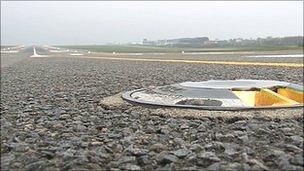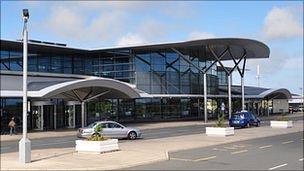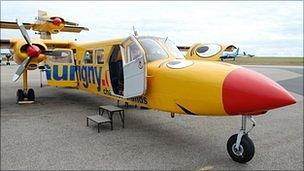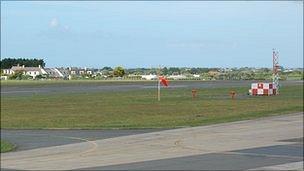Timeline: Guernsey Airport pavements project
- Published

An £80m budget has been approved for the project
More than 10 years after the first States discussions about extending Guernsey Airport's runway a refurbishment project has been approved.
The Environment Department approved plans for the island's biggest capital project, with a budget of £80m, on Tuesday.
October, 2011 The Environment Department approved the plans for the work on the runway, with 33 conditions, and the building of a temporary dock at Longue Hougue.
Proposals were submitted to house the 150 airport workers in a field in the Forest, previously temporary accommodation had been suggested at Longue Hougue.
September, 2011 Concerns over the impact on people's health caused by the work were dismissed by the airport's director.
Environmental Health said controls were being put in place to monitor and minimise the effects of noise and dust.
August, 2011 A public consultation on the airport plan defended claims the consultation was inadequate.
July, 2011 The States agreed the move to delay the debate was lost.
June, 2011 It was announced that more than 150 staff are required for the project and it was suggested that could be housed in temporary accommodation at Longue Hougue in St Sampson.
May, 2011 The States was asked to compulsory purchase more land for the landing lights, which would move as the runway was repositioned.
Before the motion came to the States, agreement was reached with the land owners.
The Public Services Department submitted the airport plans, which it had not been able to do previously as it did not own the land or have the permission of the land owners to submit the planning application. The proposals included an Environmental Impact Assessment, external.
February, 2011 The States agreed to the compulsory purchase of a field at the western end of the runway and the permanent closure of La Mare Road.
Lagan construction was chosen as the main contractor for the two-year £80m project to deal with £55m of the work.
A report into arrester bed technology found it would be £6m more expensive than extending the safety areas.
Two deputies suggested the airport redevelopment did not comply with the island's planning laws and called for an investigation. Public Services refuted the claims and said any delay could cost millions.
Those opposed to plans to extend the runway asked islanders to wear green ribbons to show their support.
January, 2011 The States deferred their decision over the compulsory purchase of land to allow another report to be prepared as deputies felt they did not have all the relevant information.
Closures of the runway were 'inevitable' during the two-year project according to the Airport Director Colin Le Ray. He said the work on the runway surface was due to take seven months and mostly take place overnight.

A new terminal building was opened in 2004
December, 2010 Public Services asked the States for approval to compulsory purchase land at the western end of Guernsey Airport's runway.
The owners said they were resigned to losing their land.
The department said it was investigating arrester bed technology, but that it was not tried and tested as Guernsey would be the first place in Europe to use it if it was included in the airport refurbishment.
October, 2010 Calls were made for a planning inquiry into the runway and safety area upgrade, with suggestions it conflicted with the island's Rural Area Plan.
Deputy Tony Spruce, from the Public Services Department, said any delay would 'impact business' and cost the island millions of pounds.
September, 2010 The word EMAS was heard for the first time as using arrester bed technology was suggested as an alternative to extending the runway.
August, 2010 A project engineer was appointed to oversee the runway redevelopment.
June, 2010 Public Services said lorries involved in the projects would be restricted to avoid disruption to islanders and residents near the airport.
The department said the runway would only close during the day if it was absolutely necessary.
The first of a number of exhibitions of the scope of the work was staged at Guernsey Airport.
March, 2010 Suggestions the airport may have to close for up to eight days during the redevelopment project were met with calls that it would 'end in chaos', external.
October, 2009 Plans to upgrade Guernsey Airport's runway were approved, external.
The budget and tender for the work remained to be agreed by the States and the plans approved by the Environment Department.
September, 2009 Members of the public expressed anger, external at plans to extend the western safety area as part of a refurbishment project, the cost of which has been estimated at £81m.
The extension was included in one of five options suggested to the States by the Public Services Department.
Airport Director Colin Le Ray said the work to update, not necessarily extend, the runway and safety areas was essential to comply with international aviation standards.
January, 2009 Islanders living near the airport discussed runway concerns, external about the large tonnage of infill necessary for some of the works including the possible lengthening of safety areas.

The States purchased the airline Aurigny for £5m
December, 2008 The States put off debating a report in a £50m project to upgrade the runway.
A majority of deputies felt the plan went beyond its remit and asked for it to be brought back after a debate on capital prioritisation in March.
The States did conclude work on the runway, aprons, safety areas and lights was essential to ensure they were compliant with international standards.
November, 2008 Essential upgrade needed 'in months', external was the finding of Jonathan Green, from RPS Group Consultants.
He said parts of the runway were "at the end of their residual life".
January, 2008 Work to upgrade the runway 'may cost up to £50m', external according to a draft report commissioned by the Public Services Department (PSD).
The report found the cost would be about £50m and if the runway was to be extended that would cost an additional £25m.
Public Services Minister Bill Bell, who had estimated the cost to be about £15m, said he was "staggered" at the cost.
Chief Minister Mike Torode told States members funds 'will be found', external.
If approved the work on the runway would start in 2009.
August, 2007 Essential work was carried out on Guernsey Airport's runway. The last time work was carried out was in 1974, 14 years after the 4,800ft (1.5km) tarmac surface was first laid.
December, 2005 Politicians reject allowing the development of land, external around the airport.
The States decided to continue protecting the land under the Rural Area Plan, but Home Minister Mike Torode said it was not because a runway extension was planned.
April, 2005 The States disagreed with a Rural Area Plan report that suggested land around the airport should be designated for runway safety areas and any possible runway extension.
April, 2004 The Board of Administration denied claims the new airport terminal building allowed less room for aircraft to park, external.
March, 2004 A new £19m terminal building, external was opened by Bailiff Sir de Vic Carey, but no changes were made to the runway during the work.

The 4,800ft tarmac runway was built in 1960
June, 2003 British Airways pulled out of the Guernsey-London Gatwick route and were replaced on the route by Aurigny.
May, 2003 The States bought Airline Aurigny for £5m and Deputy Roger Berry, the Board of Administration President, said it does not change the decision not to extend the runway, external.
February, 2003 Possibly lengthening the runway is the subject of a wide-ranging States consultation.
Islanders were asked to contribute at public presentations and interested parties, including States Committees and local organisations, were involved.
£20m of improvements, external to the runway were recommended to the States by BAe Systems.
The move was backed, external by hoteliers, the Chamber of Commerce and the Transport Consultative Committee.
December, 2001 The States agreed with the Board of Administration's report that the airport runway did not need to be extended.
Deputy Roger Berry, the Board of Administration President, reassured islanders there was no danger of airlines pulling out in the immediate future, but British Airways announced a review of its short haul routes following the decision.
November, 2001 The Board of Administration recommended to the States the runway be left at its current length for the foreseeable future.
It followed an independent report from consultants Halcrow, which suggested it should be extended to allow large aircraft to visit the island.
However, the board concluded the work, which would have cost £20m, was not necessary at the time.
November, 2000 The Board of Administration was asked by the States to investigate the costs and possible benefits of extending the runway.